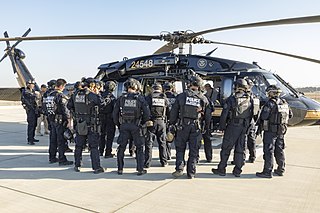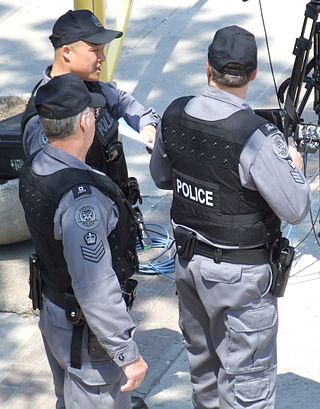
In the United States, a SWAT team is a generic term for a police tactical unit.

The Emergency Response Team are police tactical units of the Royal Canadian Mounted Police based throughout Canada and are mainly part-time teams. According to the RCMP, the ERT "is a group of highly-trained RCMP members capable of employing specialized weapons, equipment, and tactics to resolve extremely high-risk situations." The ERT is also mandated to assess the situation and determine whether extreme danger or the presence of small arms cannot be easily resolved by RCMP officers on general duties or by other police forces throughout Canada. The ERT offers consulting services to its fellow officers such as firearms files and shootings that involve police officers.

The Queensland Police Service (QPS) is the principal law enforcement agency responsible for policing the Australian state of Queensland. In 1990, the Queensland Police Force was officially renamed the Queensland Police Service and the old motto of "Firmness with Courtesy" was changed to "With Honour We Serve". The headquarters of the Queensland Police Service is located at 200 Roma Street, Brisbane.

The Emergency Task Force (ETF) is the tactical unit of the Toronto Police Service. Created in 1965, it is mandated to deal with high risk situations like hostage taking, emotionally disturbed persons, high risk arrests, warrant service, and protection details and crowd control. The Emergency Task Force is also responsible for responding to any terrorist incidents that occur throughout the City of Toronto.
The Special Emergency Response Team (SERT) was an elite police tactical unit of the Royal Canadian Mounted Police (RCMP). The SERT was formed in 1986 to provide a tactical capability to respond to major terrorist incidents throughout Canada. The unit was disbanded in 1993 when responsibility for counter terrorist response transferred from the RCMP to the Canadian Armed Forces (CAF).

Special Tasks and Rescue Group is the Police Tactical Group of the South Australia Police.
The Special Operations Group (SOG) is the police tactical group of the Victoria Police. The SOG was Australia's first full time and dedicated police tactical group when it formed in 1977.
The Special Operations Group (SOG) is the Police Tactical Group of the Tasmania Police and is the only part-time police tactical group in Australia. The SOG is transitioning to become a full-time group by 2024.

The Emergency Response Unit (ERU) is the police tactical unit of the Garda Síochána, Ireland's national police and security service. The unit was a section of the forces' Special Detective Unit (SDU), under the Crime and Security Branch (CSB) until 2017, when the Special Tactics and Operational Command was created to take over its operational duties alongside Armed Support Units.
A Police Support Unit or PSU is a unit of police officers who have undergone specialist tactical training in Public Order and Riot Control.
The Territory Response Group (TRG) is the police tactical group of the Northern Territory Police Force. The TRG is tasked to provide general and specialist support to other units of the Northern Territory Police Force (NTPF).
Until July 2012 the Specialist Response and Security Team (SRS) was a Police Tactical Group of the Australian Federal Police (AFP) having responsibility for tactical and specialist operations within the Australian Capital Territory. The Operational Response Group (ORG) had responsibility for AFP National and International tactical operations. In July 2012 the SRS was merged with the ORG to create the Specialist Response Group.
Police tactical group (PTG) is the generic term used to refer to highly trained Australian and New Zealand police tactical units that tactically manage and resolve high-risk incidents, including sieges, armed-offender situations and terrorist incidents.
The Critical Incident Response Team (CIRT) is a specialist unit of the Victoria Police that provides assistance to general duties police, including a negotiator capability, to resolve high risk incidents utilising specialist tactics and equipment. CIRT was formed to conduct regular patrols of metropolitan Melbourne 24-hours, seven-day-per-week, ready to rapidly respond to incidents in Melbourne, and if necessary, in regional Victoria, by a small team of officers. CIRT has evolved to include conducting planned operations for high risk searches and arrests.

Police in the United Kingdom use a wide range of operational vehicles, including compact cars, powerful estates and armoured police carriers. The main uses are patrol, response, tactical pursuit, and public order policing. Other vehicles used by British police include motorcycles, aircraft, and boats.
The Special Tactics Group (STG) is the full-time police tactical group of the New Zealand Police. The STG, originally named the Anti-Terrorist Squad (ATS), was established to respond to high-risk situations which are beyond the scope or capacity of everyday policing. STG officers directly support operational police in incidents, such as sieges, with specialist tactical, negotiation, intelligence, and command support services.

The Lenco BearCat is a wheeled SWAT vehicle designed for military and law enforcement use. It is in use by several military forces and law enforcement agencies around the world.
The Specialist Protective Services (SPS) is a highly trained police unit of the Australian Federal Police (AFP) consisting of a range of teams capable of deploying at short notice in order to undertake a variety of specialist policing tasks. SPS predominantly consist of sworn police officers, based in Canberra, Australian Capital Territory (ACT), who are capable of resolving high risk planned and emergency policing operations; both domestically and internationally.

The history of the Queensland Police Service in Queensland, Australia, commenced in 1864, five years after the Separation of Queensland from New South Wales in 1859. This timeline highlights significant developments in Queensland policing.









